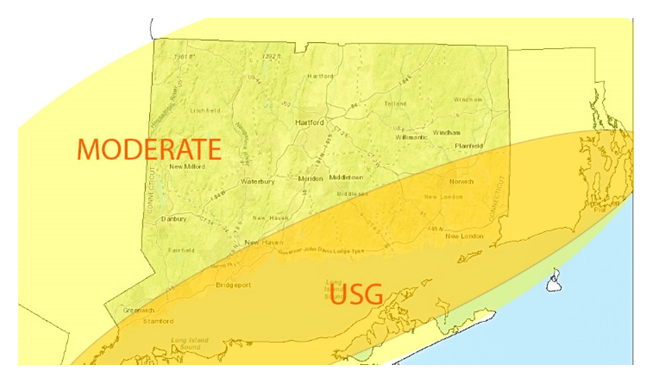Press Releases

05/01/2018
Department of Energy & Environmental Protection Forecasts Elevated Levels of Ozone for parts of Connecticut Wednesday May 2, 2018 through Thursday May 3, 2018
Connecticut’s Department of Energy and Environmental Protection (DEEP) is forecasting Unhealthy for Sensitive Groups (USG) for ozone, along south coastal areas of Connecticut beginning on Wednesday May 2, 2018, which may continue through Thursday May 3, 2018.
“Connecticut’s air quality is heavily impacted by pollution coming from outside our state, we continue to urge the EPA to take action to protect the air quality of all states,” said Commissioner Rob Klee. “After what seemed like an endless winter, it is understandable that residents will want to get outside and enjoy the warm weather, but it is important they take appropriate precautions, particularly for our most vulnerable residents – children, the elderly and those with respiratory diseases. This weather will also impact healthy adults working or exercising outdoors – to minimize health impacts while working outdoors avoid prolonged strenuous activity and best if you exercise before noon or after 8 pm.”
Health Effects of Air Pollution
When air quality is in the USG category, there is an increased likelihood of respiratory symptoms and breathing discomfort. Children and people with asthma are most at risk for experiencing symptoms. Active children and adults, and people with respiratory disease, such as asthma, should limit prolonged outdoor exertion. Peak ozone levels are predicted to occur around 2-8 PM EDT, so make sure you get your activity or exercise in before or after these times to minimize health effects.
Weather Summary
High pressure will sit off the east coast providing lots of sunshine, a steady southwest wind and temperatures well up into the 80s for next several days from Wednesday through Friday. These conditions will transport poor air quality into the state over the couple of days, but a cold front passage on Friday should lower the ozone levels. The warm and sunny weather will enable additional transported and homegrown emissions to mix into the secondary pollutant, ozone, also attributing to the poor air quality.
What You Can Do to Help
DEEP recommends simple, common sense steps to reduce your contribution to air pollution:
- Drive Clean –considered purchasing or leasing a plug-in electric vehicle. Learn more by visiting: www.driveelectricus.com;
- Drive Less - consider carpooling, vanpooling, using public transit or even telecommuting;
- Save Energy- setting air conditioners to 78o and “Wait ‘til 8” to use energy intensive appliances like washing machines, dryers and dishwashers;
- Be Aware of Your Air -Understand the Air Quality Index and sign up to receive alerts so you will know when air quality is predicted to be unhealthy; and
- When you know there will be an unhealthy air day-make small changes to your routine:
- Refuel your vehicle after dusk and stop refueling when the nozzle clicks off,
- Avoid idling your vehicle unnecessarily,
- Delay mowing your lawn or using other lawn and garden equipment until evening
- Limit your outdoor activity in the heat of the day,
- Refraining from recreational wood burning;
- Remember that knowledge is power! Ask your school if they participate in the School Flag Program, EPA’s Air Quality awareness tool that uses colored flags based on the AQI to notify teachers, students, administrators and the local community of air quality conditions.
Stay connected and access the daily AQI forecast and real-time air quality data
- Follow us on Twitter
- Sign up to get Air-Quality alerts through Enviroflash
- Visit DEEP’s AQI webpage or call 800-249-1234
- Go to EPA’s AIRNow web page
- Download EPA’s AIRnow app for your phone
Ozone Monitoring Season
DEEP monitors, tracks and forecasts daily air quality levels across Connecticut for ozone from May 1 through September 30 each year and for fine particulate matter (PM2.5) each day of the year. On April 30, 2018, DEEP began informing Connecticut’s regulated community and the general public of the ozone season via the State of Connecticut E-mail list serve and posting air quality forecasts on the DEEP web page, available here.
DEEP encourages daycare providers, summer camps and elder/senior centers to subscribe to the Air Quality Index (AQI). Subscribing to the AQI is fast and easy and will provide you with important information each day about Connecticut’s air quality through the spring and summer. The AQI link provides facts and information regarding ground-level ozone, its’ health effects, what today on high ozone day, and most importantly what you can do to help reduce ground level ozone in your backyard.

- Twitter: @CTDEEPNews
- Facebook: DEEP on Facebook

